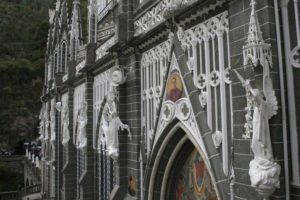Overview
[su_row]
[su_column size=”1/2″]
Hotels:
- Pick from 14 places to stay in Ipiales
- Hotels with Family rooms
- Apartments and rentals
- Best Time to Visit: Jun, Sep, Oct according to 304 reviews
- Lowest Prices: Jan, Feb
- Hotels Average price € 24
- Top Reasons to Visit Shopping Cathedrals Old Town Relaxation […]
[/su_column]
[su_column size=”1/2″]
Getting around
Insurance: Travel Insurance for Colombia
Flights: Flights to Ipiales, Colombias
Things to do: Sightseeing in Colombia
Forum: FAQ about Ipiales: 2 topics
Gifts: Medals of Divine Mercy
Cars: Rent a car in Colombia
Books: Colombia travel guides
[/su_column]
[/su_row]
Las Lajas sanctuary
The Las Lajas sanctuary is a Roman Catholic cathedral and basilica church dedicated to the veneration of Our Lady of Las Lajas Ipiales. It is located in southern Colombia and has been a tourism and pilgrimage destination since the eighteenth century.
Located 7 km from Ipiales, on a bridge which spans a spectacular gorge of the Guáitara River, is this gothic church. Legend has it that an image of the Virgin Mary appeared in the mid-18th century on an enormous rock above the river. Interestingly, the church has been constructed in such a way that the rock (and image) is its high altar.
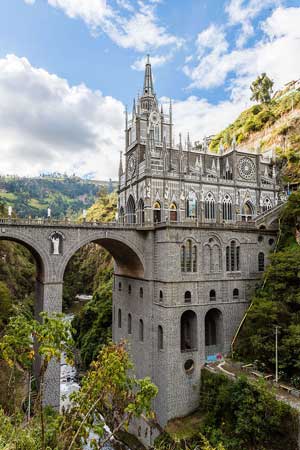
Pilgrims from all over Colombia and Ecuador journey to Las Lajas sanctuary and, unsurprisingly, reports of miracles at the site are not uncommon. Accommodation is suitably ascetic, being provided in a small but cheery convent up the road from the church.
History of the four temples
First Temple (1754)
Second Temple (1858-1893)
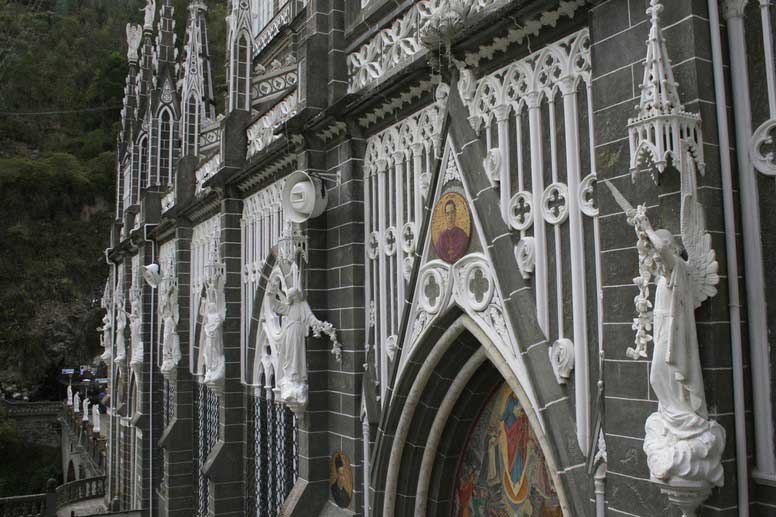

Third Temple (1859-1893)
Fourth Temple (1916)
How to get to the Las Lajas sanctuary
Taxi from the bus station in Ipiales is the easiest way to reach the church, expect to pay 4000 pesos for the taxi one way (2008).
The taxi will either choose to wait for you or you can simply take one of the many other waiting taxis eager to accept your money.
On the return journey get the taxi driver to stop at the top of the hill for a quick photo opportunity of the church nestled in the valley below.
See our Top 15 catholic shrines in the world.
See more Shrines and pilgrimages in South America
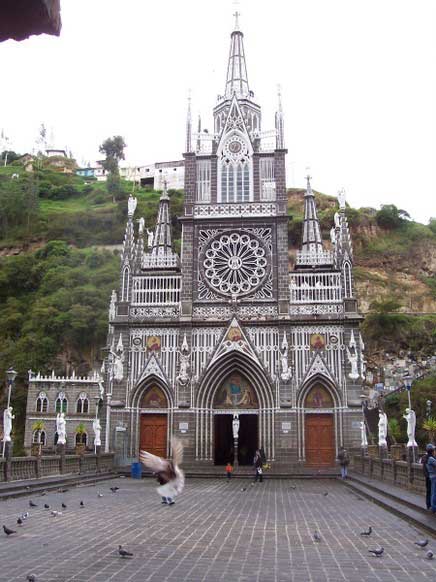

Las Lajas sanctuary Mass times
Monday – Friday
- 6.00 am, 7.00 am, 9.00 am, 11.00 am, 3.00 pm, 5.00 pm
Sundays
- 6.00 am, 7.00 am, 8.00 am, 9.00 am, 10.00 am, 11.00 am, 12.00 pm, 3.00 pm, 5.00 pm
History of the Legend
Historians and scientists are at a loss to explain this fabulous image on the wall of a South American cave. It may forever remain an enigma.
Back in the eighteenth century, María Mueses de Quiñones, an indian woman from the village of Potosi, Colombia, often walked the six miles between her village and the neighbouring one of Ipiales.


One day in 1754 as she was making the journey, she approached the place called Las Lajas (the Rock Slabs), where the trail passes through a deep gorge of the Guaitara River.
Maria never liked this part of the trail. There were rumours a cave in the Lajas was haunted. Superstitions lingered amongst the converted Christian indians.
In the indian way, she was carrying her daughter Rosa, a deaf-mute, on her back. And by the time she had climbed to the Lajas she was weary and sat on a rock to rest.


The child got down from her back to play. Next thing Rosa was by the cave shouting: “Mummy, there is a woman in here with a boy in her arms!” Maria was beside herself with the fright. For this was the first time she had heard her daughter speak.
She did not see the figures the girl was talking about, nor did she want to. She grabbed the child and hastened on to Ipiales.
When she told what happened nobody took her seriously at first. However, as the news spread some asked if maybe it was true. After all, the child was now able to speak. A few days later the child Rosa disappeared from home.
After looking everywhere the anguished Maria guessed it: her daughter must have gone to the cave.
She often said that the woman was calling her. Maria ran to Las Lajas to find her daughter kneeling in front of a splendid woman and playing affectionately with a child who had come down from His mother’s arms to let the girl enjoy His divine tenderness.
Maria fell to her knees before this beautiful spectacle; she had seen the Blessed Virgin. Fearful of ridicule, Maria kept quiet about the event. But frequently she and Rosa went to the cave to place wild flowers and candles in the cracks of the rocks.
The months went by, with María and Rosa keeping their secret. Until one day the girl fell gravely ill and died. A distraught Maria decided to take her daughter’s body to the Lajas to ask the Lady to restore Rosa to life.
Pressed by the sadness of Maria’s unrelenting supplications, the Blessed Virgin obtained Rosa’s resurrection from Her Divine Son. Overflowing with joy, Maria went home.
It didn’t take long for a crowd to gather. Early next morning everyone went to Las Lajas, each wanting to check the details for themselves.


Coronation of Our Lady of Las Lajas
In September 15, 1952, by Pope Pius XII, performed the coronation of Our Lady of Las Lajas in a solemn Mass attended by eighteen bishops of Ecuador and Colombia.
Likewise, this same pontiff gave in August 30, 1954 gi this temple the title of Minor Basilica.
The interior walls of the chapel are carved stone gray and the altar is built on the same stone cave where Rosa had visiond.
Three priests officiate masses for shifts that are very popular and are intended to pray for a favor or thank the Virgen. “The ojona” or “mulatta” are other affectionate names under which people refer a Madonna del Rosario.
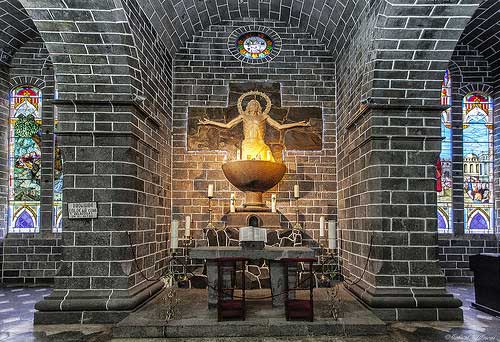

Monsignor Justin Mejia, pastor of the sanctuary for a long time, described it: “the beauty of the image of our lady of Las Lajas is something that amazes and captivates, that meets the eye and the heart, the taste of the artist and the taste of the peasant. For all eyes have a look and to every heart a beat.
Let us remain close in the same prayer! May the Lord bless you abundantly!
Video
Let us remain close in the same prayer! May the Lord bless you abundantly!
Taxi from the bus station in Ipiales is the easiest way to reach the church, expect to pay 4000 pesos for the taxi one way (2008). The taxi will either choose to wait for you or you can simply take one of the many other waiting taxis eager to accept your money. On the return journey get the taxi driver to stop at the top of the hill for a quick photo opportunity of the church nestled in the valley below.
Let us remain close in the same prayer! May the Lord bless you abundantly!
Monday – Friday
- 6.00 am, 7.00 am, 9.00 am, 11.00 am, 3.00 pm, 5.00 pm
Sundays
- 6.00 am, 7.00 am, 8.00 am, 9.00 am, 10.00 am, 11.00 am, 12.00 pm, 3.00 pm, 5.00 pm
Let us remain close in the same prayer! May the Lord bless you abundantly!
Every day, from 8.00 am to 12 Noon; 2.00 pm to 5.00 pm.
Let us remain close in the same prayer! May the Lord bless you abundantly!
Let us remain close in the same prayer! May the Lord bless you abundantly!
Let us remain close in the same prayer! May the Lord bless you abundantly!
Let us remain close in the same prayer! May the Lord bless you abundantly!
History of the Legend
Historians and scientists are at a loss to explain this fabulous image on the wall of a South American cave. It may forever remain an enigma. Back in the eighteenth century, María Mueses de Quiñones, an indian woman from the village of Potosi, Colombia, often walked the six miles between her village and the neighbouring one of Ipiales. One day in 1754 as she was making the journey, she approached the place called Las Lajas (the Rock Slabs), where the trail passes through a deep gorge of the Guaitara River. Maria never liked this part of the trail. There were rumours a cave in the Lajas was haunted. Superstitions lingered amongst the converted Christian indians.
In the indian way, she was carrying her daughter Rosa, a deaf-mute, on her back. And by the time she had climbed to the Lajas she was weary and sat on a rock to rest. The child got down from her back to play. Next thing Rosa was by the cave shouting: “Mummy, there is a woman in here with a boy in her arms!” Maria was beside herself with the fright. For this was the first time she had heard her daughter speak. She did not see the figures the girl was talking about, nor did she want to. She grabbed the child and hastened on to Ipiales.
When she told what happened nobody took her seriously at first. However, as the news spread some asked if maybe it was true. After all, the child was now able to speak. A few days later the child Rosa disappeared from home. After looking everywhere the anguished Maria guessed it: her daughter must have gone to the cave. She often said that the woman was calling her. Maria ran to Las Lajas to find her daughter kneeling in front of a splendid woman and playing affectionately with a child who had come down from His mother’s arms to let the girl enjoy His divine tenderness. Maria fell to her knees before this beautiful spectacle; she had seen the Blessed Virgin. Fearful of ridicule, Maria kept quiet about the event. But frequently she and Rosa went to the cave to place wild flowers and candles in the cracks of the rocks.
The months went by, with María and Rosa keeping their secret. Until one day the girl fell gravely ill and died. A distraught Maria decided to take her daughter’s body to the Lajas to ask the Lady to restore Rosa to life. Pressed by the sadness of Maria’s unrelenting supplications, the Blessed Virgin obtained Rosa’s resurrection from Her Divine Son. Overflowing with joy, Maria went home. It didn’t take long for a crowd to gather. Early next morning everyone went to Las Lajas, each wanting to check the details for themselves.
That was when the marvellous picture of Our Lady on the wall of the grotto was discovered. Maria Muese de Quinones could not recall noticing it until then. The child Jesus is in Our Lady’s arms. On one side of Our Lady is Saint Francis; on the other is Saint Dominic. Her delicate and regal features are those of a Latin American, perhaps an Indian. Her abundant black hair covers her like a mantle (The two-dimensional crown is metal and was added by devotees much later on). Her eyes sparkle with a pure and friendly joy. She looks about fourteen years old. The indians had no doubt: this was their queen.
As devotion to the image grew, a good road replaced the old trail. In the early 20th century a tasteful gothic church was built over the cave.
But who put this magnificent image there? The author has never been identified! Scoffers say the wily Dominicans sneaked in a good artist, and the gullible indians are still being fooled. But tests done when the church was built show how stupendous this image actually is. Geologists from Germany bored core samples from several spots in the image. There is no paint, no dye, nor any other pigment on the surface of the rock. The colours are the colours of the rock itself. Even more incredible, the rock is perfectly coloured to a depth of several feet! So the mystery remains unsolved. Did angels do it? Or did God Himself do it at the dawn of creation, when he contemplated the most excellent of all His creatures? The One whom He would make Queen of Heaven and Earth. And to whose maternal care the future nation of Colombia would be entrusted.






